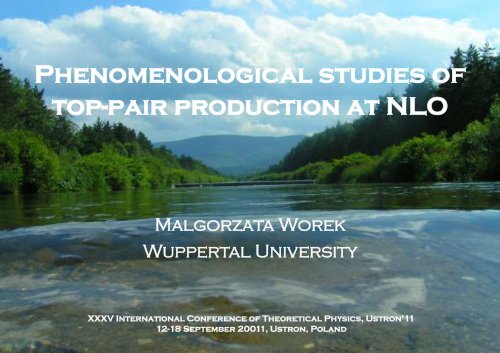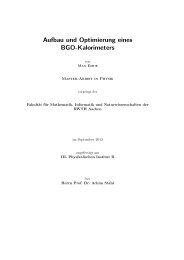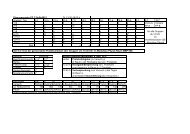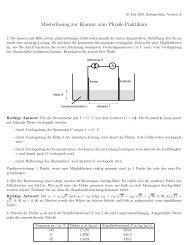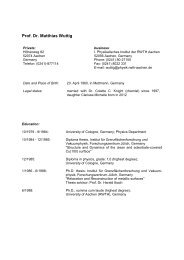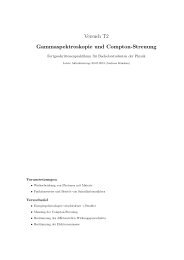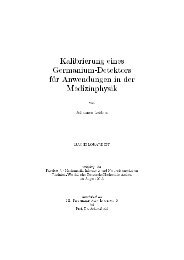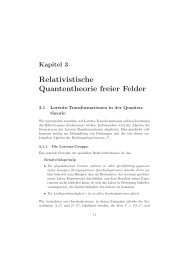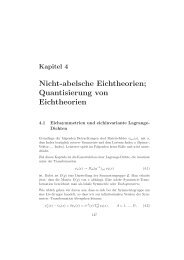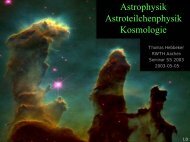Phenomenological studies of top-pair production at NLO
Phenomenological studies of top-pair production at NLO
Phenomenological studies of top-pair production at NLO
You also want an ePaper? Increase the reach of your titles
YUMPU automatically turns print PDFs into web optimized ePapers that Google loves.
<strong>Phenomenological</strong> <strong>studies</strong> <strong>of</strong><br />
<strong>top</strong>-<strong>pair</strong> <strong>production</strong> <strong>at</strong> <strong>NLO</strong><br />
Malgorz<strong>at</strong>a Worek<br />
Wuppertal University<br />
XXXV Intern<strong>at</strong>ional Conference <strong>of</strong> Theoretical Physics, Ustron’11<br />
12-18 September 20011, Ustron, Poland 1
Outline<br />
General motiv<strong>at</strong>ion for <strong>NLO</strong> QCD calcul<strong>at</strong>ions<br />
HELAC-<strong>NLO</strong> in a nutshell<br />
ttbb, ttjj, Htt, WWbb<br />
Applic<strong>at</strong>ions: WWbb & ttjj @ TeV<strong>at</strong>ron and LHC<br />
Summary & Outlook<br />
2
HELAC-<strong>NLO</strong> Group<br />
G. Bevilacqua (RWTH Aachen)<br />
M. Czakon (RWTH Aachen)<br />
M.V. Garzelli (Debrecen Uni.)<br />
A. van Hameren (INP Krakow)<br />
I. Malamos (Nijmegen Uni.)<br />
C. G. Papadopoulos (INP Athens)<br />
R. Pittau (Granada Uni.)<br />
M. Worek (Wuppertal Uni.)<br />
<br />
<br />
<br />
<br />
<br />
<br />
Contributors:<br />
A. Kanaki<br />
A. Cafarella<br />
P. Draggiotis (Valencia Uni.)<br />
G. Ossola (New York Uni.)<br />
3
Introduction<br />
8-10 partons in the final st<strong>at</strong>e @ LO, well separ<strong>at</strong>ed to avoid divergences<br />
Standard Model and beyond tools @ tree level (just few examples)<br />
ALPGEN, AMEGIC++/SHERPA, CARLOMAT, COMIX/SHERPA,<br />
COMPHEP, HELAC-PHEGAS, MADGRAPH/MADEVENT,<br />
O'MEGA/WHIZARD, ...<br />
General purpose Monte Carlo programs (parton shower, hadroniz<strong>at</strong>ion,<br />
multiple interactions, hadrons decays, etc.)<br />
HERWIG, HERWIG++, PYTHIA 6.4, PYTHIA 8.1, SHERPA, ...<br />
High sensitivity to unphysical input scales<br />
Higher order calcul<strong>at</strong>ions are needed to improve accuracy <strong>of</strong> prediction<br />
4
Motiv<strong>at</strong>ion for <strong>NLO</strong><br />
Stabilizing the scale in the QCD input parameters:<br />
Strong coupling constant and PDFs<br />
More reliable theoretical error rel<strong>at</strong>ed to the scale dependence<br />
Normaliz<strong>at</strong>ion and shape <strong>of</strong> distributions first known <strong>at</strong> <strong>NLO</strong><br />
Many scale processes: V+ jets, ttH, tt + jets, bb + jets, njets ...<br />
How do we know which scale to choose ?<br />
Improved description <strong>of</strong> jets<br />
Jets: LO <strong>NLO</strong> Parton Hadron<br />
Shower<br />
Level<br />
5
Structure <strong>of</strong> <strong>NLO</strong><br />
Calcul<strong>at</strong>ions<br />
<br />
σ <strong>NLO</strong> =<br />
<br />
=<br />
m<br />
m<br />
<br />
dσ B +<br />
<br />
dσ B +<br />
m+1<br />
m+1<br />
<br />
dσ R −<br />
m+1<br />
<br />
dσ A +<br />
<br />
dσ R − dσ D <br />
+<br />
m<br />
m+1<br />
<br />
dσ A +<br />
m<br />
dσ V<br />
<br />
dσ V + dσ I + dσ KP<br />
C<strong>at</strong>ani-Seymour subtraction scheme<br />
At <strong>NLO</strong>: dσ R with m+1 partons and dσ V with m partons in the final<br />
Separ<strong>at</strong>ely divergent although their sum is finite<br />
dσ A is a proper approxim<strong>at</strong>ion <strong>of</strong> dσ R<br />
i. same singular behavior point-by-point<br />
ii. integrable over extra parton degrees <strong>of</strong> freedom<br />
Individual contributions finite. MC integr<strong>at</strong>ion can be performed !
Structure <strong>of</strong> <strong>NLO</strong><br />
Calcul<strong>at</strong>ions<br />
<br />
σ <strong>NLO</strong> =<br />
<br />
=<br />
m<br />
m<br />
<br />
dσ B +<br />
<br />
dσ B +<br />
m+1<br />
m+1<br />
<br />
dσ R −<br />
m+1<br />
<br />
dσ A +<br />
<br />
dσ R − dσ D <br />
+<br />
m<br />
m+1<br />
<br />
dσ A +<br />
m<br />
dσ V<br />
<br />
dσ V + dσ I + dσ KP<br />
Three main building blocks are needed<br />
Evalu<strong>at</strong>ion <strong>of</strong> one-loop amplitude - HELAC-1LOOP<br />
Determin<strong>at</strong>ion <strong>of</strong> coefficients via reduction method<br />
Reduction <strong>at</strong> integrand level - OPP method - CUTTOOLS<br />
Evalu<strong>at</strong>ion <strong>of</strong> scalar functions - ONELOOP<br />
Ossola, Papadopoulos, Pittau ‘07, ’08<br />
Draggiotis, Garzelli, Papadopoulos, Pittau ’09<br />
Garzelli, Malamos, Pittau ’09<br />
van Hameren, Papadopoulos, Pittau ’09<br />
van Hameren, ’10<br />
7
Structure <strong>of</strong> <strong>NLO</strong><br />
Calcul<strong>at</strong>ions<br />
<br />
σ <strong>NLO</strong> =<br />
<br />
=<br />
m<br />
m<br />
<br />
dσ B +<br />
<br />
dσ B +<br />
m+1<br />
m+1<br />
<br />
dσ R −<br />
m+1<br />
<br />
dσ A +<br />
<br />
dσ R − dσ D <br />
+<br />
m<br />
m+1<br />
<br />
dσ A +<br />
m<br />
dσ V<br />
<br />
dσ V + dσ I + dσ KP<br />
HELAC-DIPOLES - complete, public and autom<strong>at</strong>ic C<strong>at</strong>ani-Seymour dipoles<br />
Extended for arbitrary polariz<strong>at</strong>ions<br />
Monte Carlo over polariz<strong>at</strong>ion st<strong>at</strong>es <strong>of</strong> external particles<br />
Monte Carlo over color<br />
Phase space restriction on the dipoles phase space<br />
Less dipole subtraction terms per event<br />
Increased numerical stability<br />
Reduced missed binning problem<br />
Czakon, Papadopoulos, Worek '09<br />
8
One-loop amplitude<br />
and r<strong>at</strong>ional part<br />
Reduction <strong>of</strong> tensor integrals<br />
OPP coefficients and r<strong>at</strong>ional part<br />
HELAC-1LOOP<br />
CUTTOOLS<br />
pp → t¯tjj<br />
HELAC-<strong>NLO</strong><br />
HELAC-<br />
DIPOLES<br />
ONELOOP<br />
C<strong>at</strong>ani-Seymour dipole subtraction<br />
for massless and massive cases<br />
Scalar integrals<br />
9
Top Quark<br />
Produced in hadron-hadron collisions through strong interactions<br />
Decays without forming hadrons through the single mode tW b<br />
Distinguished by its large mass, close to EW symmetry breaking scale<br />
Unique property raises questions:<br />
Is the <strong>top</strong> quark mass gener<strong>at</strong>ed by the Higgs mechanism ?<br />
Does it play more fundamental role ?<br />
Are there new particles lighter than the <strong>top</strong> quark ?<br />
Does the <strong>top</strong> quark decay into them ?<br />
Could non-SM physics manifest itself in non-standard couplings <strong>of</strong> <strong>top</strong><br />
quark which show up as anomalies in <strong>top</strong> quark <strong>production</strong> and decays?<br />
Top quark physics tries to answer all these questions<br />
Properties <strong>of</strong> the <strong>top</strong> quark have already been examined <strong>at</strong> the Tev<strong>at</strong>ron<br />
LHC is a <strong>top</strong> factory, producing about 8 million tt <strong>pair</strong>s per<br />
experiment per year <strong>at</strong> low luminosity (10 fb 1 /year)<br />
10
Top Pair Production<br />
Complete <strong>of</strong>f-shell effects @ <strong>NLO</strong><br />
Double-, single- and non-resonant<br />
<strong>top</strong> contributions <strong>of</strong> the order O( s3 4 )<br />
Complex-mass scheme for unstable <strong>top</strong><br />
W gauge bosons are tre<strong>at</strong>ed <strong>of</strong>f-shell<br />
pp(p¯p) → e + ν e µ − ν µ b¯b + X<br />
Sum over helicities and color via MC<br />
LO + V obtained by reweighting <strong>of</strong> tree<br />
level unweighted events<br />
Dipole channels for subtracted real part<br />
Check <strong>of</strong> Ward identity for virtual part<br />
Cancell<strong>at</strong>ion <strong>of</strong> divergences<br />
max independence test for real part<br />
Bevilacqua, Czakon, van Hameren, Papadopoulos, Worek ’11<br />
11
Top Pair Production<br />
TeV<strong>at</strong>ron<br />
LO & <strong>NLO</strong> scale dependence<br />
σ LO = 34.922 +40%<br />
−26% fb<br />
σ <strong>NLO</strong> = 35.727 −4%<br />
−8% fb<br />
K = 1.023<br />
LHC<br />
σ LO = 550.538 +37%<br />
−25% fb<br />
σ <strong>NLO</strong> = 808.665 +4%<br />
−9% fb<br />
K = 1.47<br />
Bevilacqua, Czakon, van Hameren, Papadopoulos, Worek ’11<br />
12
Top Pair Production<br />
TeV<strong>at</strong>ron<br />
Differential cross section<br />
Fixed scale m t<br />
Not rescale LO shapes<br />
Distortions 15% - 80%<br />
For angular distributions<br />
corrections 5% - 10%<br />
Bevilacqua, Czakon, van Hameren, Papadopoulos, Worek ’11<br />
13
Top Pair Production<br />
LHC<br />
Differential cross section<br />
Fixed scale m t<br />
Corrections 50% - 60 %<br />
Rel<strong>at</strong>ively constant<br />
H T distorted up to 80%<br />
Bevilacqua, Czakon, van Hameren, Papadopoulos, Worek ’11<br />
14
TeV<strong>at</strong>ron<br />
Top Pair Production<br />
A t FB =0.051<br />
A b FB =0.033<br />
A +<br />
FB =0.034<br />
<strong>top</strong> quarks are emitted in the<br />
direction <strong>of</strong> incoming protons<br />
<br />
A t y>0<br />
FB =<br />
N t(y) − y0 N t(y)+ y
Top Pair + 2 Jets<br />
Important background for Higgs searches @ Tev<strong>at</strong>ron and @ LHC<br />
H WW ∗ produced via weak boson fusion<br />
For m H ~ 130 GeV, i.e. when BR(H WW ∗ ) is large enough<br />
Higgs boson mass peak cannot be directly reconstructed<br />
Background processes can not be measured from the side bands<br />
H bb produced via associ<strong>at</strong>ed <strong>production</strong> with a tt <strong>pair</strong><br />
Process useful only in the low mass range m H < 135 GeV<br />
Unique access to the <strong>top</strong> and bottom Yukawa couplings<br />
Reconstruction <strong>of</strong> the H bb mass peak difficult<br />
The bb <strong>pair</strong> can be chosen incorrectly<br />
b-tagging efficiency, two b-jets can arise from mistagged light jets<br />
Very precise knowledge <strong>of</strong> QCD backgrounds<br />
ttjj, ttbb, WWjj is necessary !<br />
16
Top Pair + 2 Jets<br />
Partonic subprocesses<br />
Number <strong>of</strong> Feynman diagrams<br />
Number <strong>of</strong> dipoles<br />
As a measure <strong>of</strong> complexity<br />
dσ R − dσ D<br />
dσ V<br />
Bevilacqua, Czakon, Papadopoulos, Worek ’10 ‘11<br />
17
Top Pair + 2 Jets<br />
TeV<strong>at</strong>ron<br />
σ LO =0.3584 +94%<br />
−45% pb<br />
σ <strong>NLO</strong> =0.2709 +0.5%<br />
−21% pb<br />
94% 21%<br />
K = 0.76 -24%<br />
Total cross sections<br />
with different jets<br />
separ<strong>at</strong>ion cuts R jj<br />
and the jet resolution<br />
parameters R<br />
K = 0.86 -14%<br />
Bevilacqua, Czakon, Papadopoulos, Worek ’10 ‘11<br />
18
TeV<strong>at</strong>ron<br />
Top Pair + 2 Jets<br />
Corrections to p T and m tt<br />
are substantial<br />
Do not simply rescale the<br />
LO shapes<br />
Induce distortions 40%<br />
For H T even 50% 60%<br />
deform<strong>at</strong>ions<br />
Bevilacqua, Czakon, Papadopoulos, Worek ’10 ‘11<br />
19
TeV<strong>at</strong>ron<br />
Top Pair + 2 Jets<br />
Angular distributions<br />
Neg<strong>at</strong>ive and moder<strong>at</strong>e<br />
corrections<br />
15% 30%<br />
Rel<strong>at</strong>ively constant<br />
Bevilacqua, Czakon, Papadopoulos, Worek ’10 ‘11<br />
20
Top Pair + 2 Jets<br />
A t FB,LO = −0.103 +0.003<br />
−0.004<br />
A t FB,<strong>NLO</strong> = −0.046 +0.005<br />
−0.006<br />
anti-<strong>top</strong> quarks are emitted in the<br />
direction <strong>of</strong> incoming protons<br />
(forward direction by definition)<br />
with a consistent expansion in s<br />
A t FB,<strong>NLO</strong> = −0.058 +0.014<br />
−0.042<br />
unexpanded r<strong>at</strong>io <strong>of</strong> the <strong>NLO</strong> cross sections<br />
Bevilacqua, Czakon, Papadopoulos, Worek ’10 ‘11<br />
21
Top Pair + 2 Jets<br />
LHC<br />
σ LO = 13.398 +87%<br />
−43% pb<br />
σ <strong>NLO</strong> =9.82 −15%<br />
−15% pb<br />
87% 15%<br />
K = 0.73 -27%<br />
Total cross sections<br />
with different jets<br />
separ<strong>at</strong>ion cuts R jj<br />
and the jet resolution<br />
parameters R<br />
K = 0.86 -14%<br />
Bevilacqua, Czakon, Papadopoulos, Worek ’10 ‘11<br />
22
LHC<br />
Top Pair + 2 Jets<br />
m tt 20% 30% corrections<br />
p T up to 60% distortions<br />
H T even 80% deform<strong>at</strong>ions<br />
Corrections are substantial<br />
and do not simply rescale<br />
LO shapes<br />
Bevilacqua, Czakon, Papadopoulos, Worek ‘10 ’11<br />
23
LHC<br />
Top Pair + 2 Jets<br />
<strong>NLO</strong> QCD corrections<br />
are neg<strong>at</strong>ive and<br />
rel<strong>at</strong>ively constant<br />
Angular distributions<br />
20% 30% corrections<br />
Bevilacqua, Czakon, Papadopoulos, Worek ’1o ‘11<br />
24
Summary & Outlook<br />
Already calcul<strong>at</strong>ed by HELAC-<strong>NLO</strong>: ttbb, ttjj, Htt, WWbb<br />
ttbb, WWbb completed by two groups<br />
Permille level agreement in both cases!<br />
Much wider study for ttjj: vari<strong>at</strong>ion <strong>of</strong> the center <strong>of</strong> mass energy, jet<br />
algorithms, cone size in jet algorithm, transverse momentum cuts<br />
HELAC-<strong>NLO</strong><br />
Complete tool <strong>at</strong> <strong>NLO</strong> built around HELAC‐PHEGAS:<br />
HELAC‐1LOOP, CUTTOOLS, ONELOOP, HELAC‐DIPOLES<br />
Other processes from <strong>NLO</strong> Wishlist under <strong>at</strong>tack<br />
Constant improvements in speed and functionality<br />
Interfaced to PYTHIA and HERWIG showers via POWHEG-BOX: ttj, ttH<br />
Decays <strong>of</strong> massive particles, showering and hadroniz<strong>at</strong>ion<br />
Final results <strong>at</strong> the hadron level<br />
http://helac-phegas.web.cern.ch/helac-phegas/<br />
25


